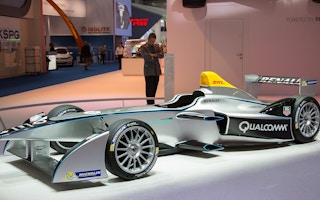AT THE Frankfurt motor show this month a new type of racing car was unveiled. Although it looks conventional, the SRT-01E is powered by an electric motor and a battery. These cars will be used in a new all-electric grand prix called Formula E, which gets under way in London in September 2014. Other races are planned in Bangkok, Beijing, Berlin, Buenos Aires, Los Angeles, Miami, Monaco, Putrajaya, Rio de Janeiro and Rome. But will anyone want to watch, given that electric racing cars are slower than Formula 1 cars and, being battery-powered, have a far shorter range?
The event is the idea of the Fédération Internationale de l’Automobile (FIA), the ruling body of F1. And just as its premier race series has helped drive innovation in the engines, brakes, suspension and aerodynamics of everyday cars, the hope is that Formula E will help boost the performance of electric vehicles. For the first season, however, all of the ten teams taking part will use SRT-01Es. If this proves to be a success, the teams will be allowed to develop their own vehicles and power systems in subsequent years. With identical cars with limited speed and range, it means the FIA needs to make the first Formula E championship as exciting as possible. To do that it has come up with some special rules.
“
A greener, more sustainable grand prix is seen as a way to attract more sponsorship. Some big names have already signed up to support Formula E, including DHL, a logistics giant, and Qualcomm, an American technology group
Each of the ten teams will have two drivers. But unlike F1, each driver will have two cars. Hence 40 SRT-01Es in all are being built by Spark Racing Technologies, a French firm, in collaboration with Renault and a number of other motorsports companies, including McLaren, Michelin and Williams. With present battery technology the cars will run out of juice after about 25 minutes in a race that is supposed to last around an hour. So each driver must make at least two pit-stops to change cars—sprinting 100 metres between each car in the old Le Mans style. As an added twist, one of the cars will be a sprint version capable of greater acceleration while the other will have more endurance. Flat out, the SRT-01Es will reach a top speed of around 225kph (140mph), whereas F1 cars top 300kph on some circuits. But on the short, twisting closed-off city streets which will be used by the electric racers, they will be spectacularly quick. And because of the instant torque provided by electric motors, they can accelerate to 100kph in just three seconds. Nor will they be quiet, because of the sound made by the cars’ tyres, electric motors and aerodynamics at speed. The SRT-01Es will also use electronic generators to make a whooshing noise, at least when in the pit lane to alert mechanics. In addition, spectators will be able to interact with the cars using social media. The talk is of allowing them to award drivers extra goes on their “push-to-pass” boost buttons, which give a bit of extra speed for overtaking.
Creating a wider audience for motor racing is a big part of the FIA’s strategy. A greener, more sustainable grand prix is seen as a way to attract more sponsorship. Some big names have already signed up to support Formula E, including DHL, a logistics giant, and Qualcomm, an American technology group. But the commercial potential, and the ability to draw a large audience, will need to be proved before Formula E becomes a technological race. Then, provided the teams can come up with better batteries, electric motors and power electronics, electric racing cars really could, one day, mount a serious challenge to the petrol-heads’ F1 cars.
This post originally appeared here.

















